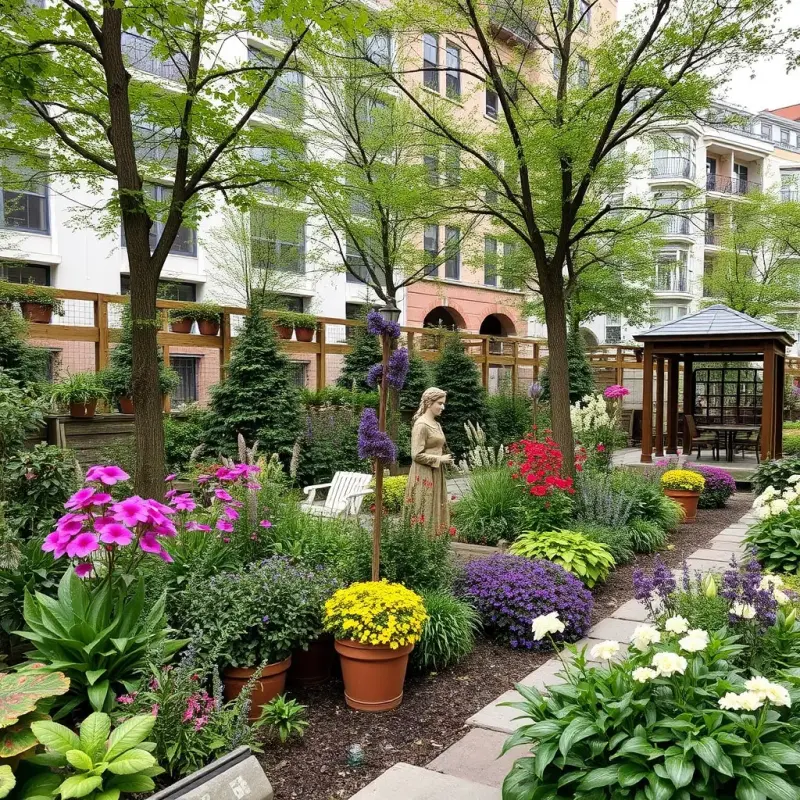Eco-Friendly Solutions for Creating Miniature Urban Gardens: How Devices Aid in Greening Metropolises
In the face of rapid urbanization, cities worldwide are seeking sustainable methods to integrate greenery into dense environments. Miniature urban gardens have emerged as a viable solution, offering environmental and social benefits. Advancements in technology have introduced devices that simplify the creation and maintenance of these green spaces, promoting eco-friendly practices in metropolitan areas.

The Rise of Miniature Urban Gardens
Urban gardening involves cultivating plants within city environments, utilizing spaces such as balconies, rooftops, and vacant lots. This practice enhances air quality, reduces urban heat islands, and fosters community engagement. Miniature urban gardens, in particular, are compact and adaptable, making them suitable for limited spaces.
Eco-Friendly Devices Facilitating Urban Greening
Technological innovations have led to the development of devices that support sustainable urban gardening:
-
Smart Irrigation Systems: These systems optimize water usage by monitoring soil moisture and weather conditions, ensuring plants receive adequate hydration without waste.
-
Vertical Gardening Kits: Designed for small spaces, these kits allow for vertical plant growth, maximizing green coverage in confined areas.
-
Composting Units: Compact composters enable urban dwellers to recycle organic waste into nutrient-rich soil, promoting sustainable gardening practices.
-
Hydroponic Systems: These soil-less growing setups are ideal for indoor environments, allowing for efficient cultivation of various plants.
-
Solar-Powered Garden Lights: Utilizing renewable energy, these lights illuminate gardens without increasing electricity consumption.
Benefits of Integrating Eco-Friendly Devices
Incorporating these devices into urban gardening offers several advantages:
-
Resource Efficiency: Smart irrigation and hydroponic systems reduce water usage, addressing concerns of resource scarcity.
-
Space Optimization: Vertical gardening kits and compact composters make effective use of limited urban spaces.
-
Environmental Impact: Solar-powered devices and composting units minimize carbon footprints and waste.
-
Community Engagement: Accessible gardening technologies encourage urban residents to participate in greening initiatives, fostering a sense of community.
Challenges and Considerations
While these devices offer numerous benefits, certain challenges exist:
-
Initial Investment: The cost of acquiring and installing advanced gardening devices may be a barrier for some individuals.
-
Maintenance Requirements: Some systems require regular upkeep, which may be demanding for users with limited time.
-
Technical Proficiency: Operating smart devices may necessitate a basic understanding of technology, potentially limiting accessibility.
Future Prospects
The integration of eco-friendly devices in urban gardening is poised to grow, driven by technological advancements and increased environmental awareness. Future developments may focus on enhancing affordability, user-friendliness, and efficiency, making sustainable urban gardening more accessible to a broader population.
Innovative Trends and the Future of Urban Gardening
Urban gardening is evolving beyond traditional methods, with innovations that blend technology, sustainability, and aesthetics. Here are some emerging trends that are reshaping how we think about greening urban spaces.
Biophilic Design and Green Architecture
One of the most notable trends is biophilic design, which integrates natural elements into architectural plans. From green walls to entire buildings enveloped in foliage, biophilic architecture aims to connect urban dwellers with nature. These structures not only add visual appeal but also contribute to improved air quality, reduced energy consumption, and a healthier urban ecosystem.
Modular Urban Gardens
Modular garden systems are gaining traction, offering a flexible solution for urban residents. These systems are pre-designed, scalable kits that can be easily assembled and disassembled. They cater to renters who may need to relocate or people who wish to adapt their green spaces as seasons change. Modular setups make urban gardening more practical and customizable, fitting into various settings from rooftops to small terraces.
Air-Purifying Plant Technology
Another exciting development is air-purifying plant technology. Scientists are working to enhance the air-cleansing properties of common houseplants using biotechnology. This research focuses on increasing a plant’s ability to filter toxins and pollutants from the air. Integrating these improved plants into urban gardens could provide an efficient way to combat air pollution in cities.
Community-Driven Urban Farms
Beyond individual efforts, community-driven urban farms are becoming more widespread. These shared green spaces encourage collaboration among residents, providing fresh produce and a sense of belonging. Technological platforms, such as apps for community coordination and scheduling, are supporting the growth of these urban farms. They also promote educational opportunities, teaching urban dwellers about sustainable agriculture and environmental stewardship.
Data-Driven Gardening
Data analytics and IoT (Internet of Things) technology are now being used in urban gardening to make informed decisions about plant care. Sensors can monitor soil health, air quality, and weather patterns, providing real-time feedback. This data allows gardeners to optimize growing conditions, improve plant health, and increase yields. It also helps urban planners to understand the impact of greenery on city environments, enabling more efficient resource allocation and maintenance.
Pop-Up Urban Gardens and Green Initiatives
Pop-up urban gardens are temporary installations designed to add greenery to vacant lots or underutilized spaces. Often backed by city governments or local organizations, these initiatives transform dull, concrete areas into vibrant, plant-filled environments. These projects can serve as prototypes for more permanent urban greening efforts, showcasing how even small-scale green spaces can have a substantial impact on urban well-being.
Connecting Urban Green Spaces with Technology
The future of urban gardening lies in smart, interconnected systems. Imagine a city where green spaces are networked, communicating with each other and urban infrastructure. Automated drones could monitor plant health, while AI-driven platforms predict optimal planting strategies based on weather forecasts. This level of connectivity would ensure that urban green spaces remain lush and thriving, even in the face of environmental challenges.
These advancements reflect a broader commitment to integrating nature into urban settings, making our cities more sustainable and enjoyable. As technology and eco-friendly practices continue to converge, urban gardening is set to become an even more vital part of city living. The potential to transform gray concrete landscapes into vibrant, green ecosystems is not only inspiring but essential for the future of our urban environments.
Artykuły
Subskrybuj nasze wiadomości, aby zawsze być na bieżąco z najnowszymi i najbardziej ekscytującymi artykułami dostarczanymi na Twój e-mail!